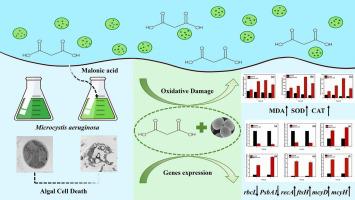当前位置:
X-MOL 学术
›
Algal. Res.
›
论文详情
Our official English website, www.x-mol.net, welcomes your
feedback! (Note: you will need to create a separate account there.)
Inhibitory effect of malonic acid on Microcystis aeruginosa: Cell morphology, oxidative stress and gene expression
Algal Research ( IF 4.6 ) Pub Date : 2024-04-18 , DOI: 10.1016/j.algal.2024.103513 Chunyang Tao , Xiaojun Niu , Dongqing Zhang , Yuejin Liu , Lingling Zhou , Yunhao Han , Yujing Mo , Kaixin Wu , Yu Lin , Zhang Lin
Algal Research ( IF 4.6 ) Pub Date : 2024-04-18 , DOI: 10.1016/j.algal.2024.103513 Chunyang Tao , Xiaojun Niu , Dongqing Zhang , Yuejin Liu , Lingling Zhou , Yunhao Han , Yujing Mo , Kaixin Wu , Yu Lin , Zhang Lin

|
The utilization of allelochemicals, which are regarded as eco-friendly algaecides for mitigating harmful cyanobacterial blooms (HCB), has attracted increasing attention, owing to their negligible toxicity, high selectivity and excellent degradability. In the present study, the inhibitory effects of malonic acid on were investigated in terms of growth indicators, cell morphology, antioxidant enzymes activities and gene expression. The results indicated that the exposure to 0.5 mmol L malonic acid for 7 d caused a high microalgae inhibition rate of 86.88 %. Furthermore, the analysis of scanning electron microscopy (SEM) and transmission electron microscope (TEM) showed that the presence of malonic acid resulted in the disruption of cell integrity and the changes in cell morphology. Specifically, malonic acid was observed to cleave microalgae cells, while concurrently oxidizing the microalgae organic matter. In addition, under the exposure of 0.5 mmol L malonic acid, the levels of malondialdehyde (MDA) were 3.28 times as the control group on d-5, while the activities of superoxide dismutase (SOD) and catalase (CAT) were first increased by 5.96 and 11.73 fold compare to the control group on d-5, and then decreased, due to oxidative stress induced by malonic acid. Transcriptome-based gene expression analysis revealed that the presence of malonic acid significantly inhibited the transcription of genes (, ) associated with photosynthesis, and the expression of DNA repair gene (), stress response gene () and microcystin synthesis genes (, ) were up-regulated. These findings provide novel insights into the inhibitory effect of malonic acid on , suggesting that malonic acid has the potential to control blooms.
中文翻译:

丙二酸对铜绿微囊藻的抑制作用:细胞形态、氧化应激和基因表达
化感化学物质被认为是用于减轻有害蓝藻水华(HCB)的环境友好型除藻剂,由于其毒性可忽略不计、选择性高和优异的降解性,已引起越来越多的关注。本研究从生长指标、细胞形态、抗氧化酶活性和基因表达等方面研究了丙二酸对其的抑制作用。结果表明,0.5 mmol·L-1丙二酸作用7 d,对微藻的抑制率高达86.88%。此外,扫描电子显微镜(SEM)和透射电子显微镜(TEM)的分析表明,丙二酸的存在导致细胞完整性的破坏和细胞形态的变化。具体而言,观察到丙二酸裂解微藻细胞,同时氧化微藻有机物。此外,在0.5 mmol·L丙二酸作用下,第5天丙二醛(MDA)水平是对照组的3.28倍,而超氧化物歧化酶(SOD)和过氧化氢酶(CAT)活性首先升高d-5时为对照组的5.96倍和11.73倍,然后由于丙二酸诱导的氧化应激而下降。基于转录组的基因表达分析表明,丙二酸的存在显着抑制了与光合作用相关的基因(, )的转录,并且DNA修复基因( )、应激反应基因( )和微囊藻毒素合成基因( , )的表达量上调-受监管。这些发现为丙二酸对 的抑制作用提供了新的见解,表明丙二酸具有控制水华的潜力。
更新日期:2024-04-18
中文翻译:

丙二酸对铜绿微囊藻的抑制作用:细胞形态、氧化应激和基因表达
化感化学物质被认为是用于减轻有害蓝藻水华(HCB)的环境友好型除藻剂,由于其毒性可忽略不计、选择性高和优异的降解性,已引起越来越多的关注。本研究从生长指标、细胞形态、抗氧化酶活性和基因表达等方面研究了丙二酸对其的抑制作用。结果表明,0.5 mmol·L-1丙二酸作用7 d,对微藻的抑制率高达86.88%。此外,扫描电子显微镜(SEM)和透射电子显微镜(TEM)的分析表明,丙二酸的存在导致细胞完整性的破坏和细胞形态的变化。具体而言,观察到丙二酸裂解微藻细胞,同时氧化微藻有机物。此外,在0.5 mmol·L丙二酸作用下,第5天丙二醛(MDA)水平是对照组的3.28倍,而超氧化物歧化酶(SOD)和过氧化氢酶(CAT)活性首先升高d-5时为对照组的5.96倍和11.73倍,然后由于丙二酸诱导的氧化应激而下降。基于转录组的基因表达分析表明,丙二酸的存在显着抑制了与光合作用相关的基因(, )的转录,并且DNA修复基因( )、应激反应基因( )和微囊藻毒素合成基因( , )的表达量上调-受监管。这些发现为丙二酸对 的抑制作用提供了新的见解,表明丙二酸具有控制水华的潜力。





















































 京公网安备 11010802027423号
京公网安备 11010802027423号